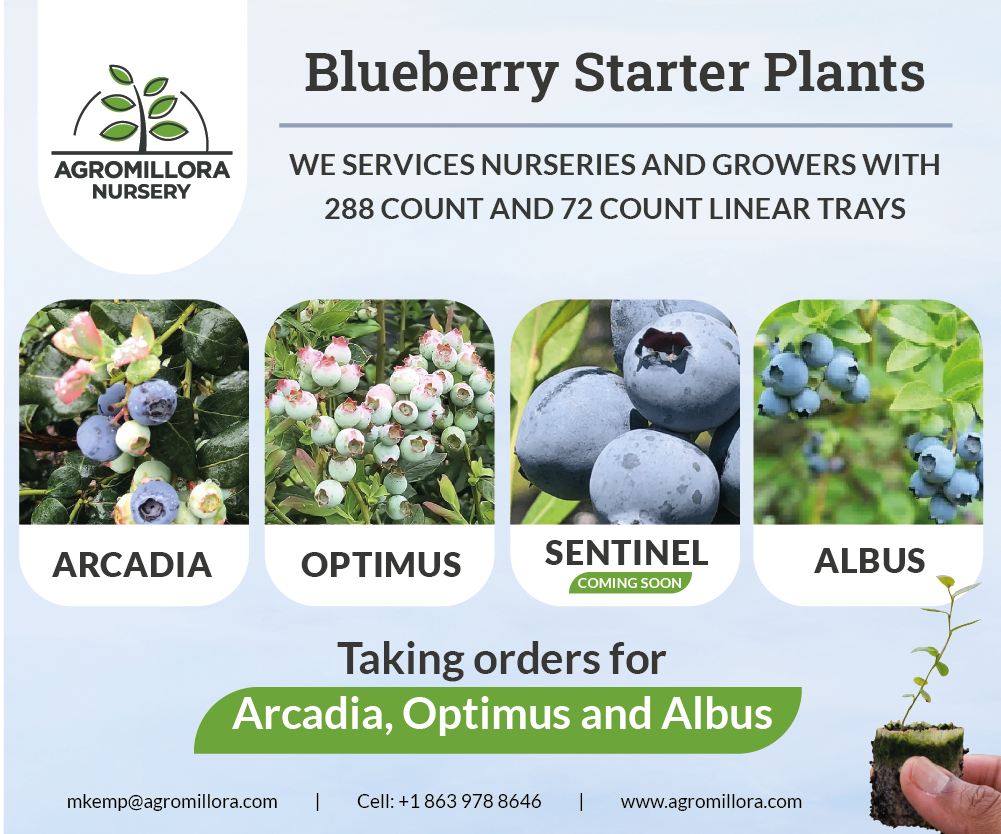A Closer Look at the Symptoms and Management of Phytophthora Root Rot
The most common and destructive root rot disease of southern highbush blueberry (SHB) in Florida is Phytophthora root rot (PRR) caused by the oomycete pathogen Phytophthora cinnamomi. PRR is a persistent problem that is currently managed through careful site selection, preparation, and routine Phytophthora-specific fungicide applications.
Disease Cycle
Phytophthoracinnamomi survives on dead and decaying plant tissues in Florida soils and should be assumed to be a potential problem on all farms with favorable disease conditions. Like all plant diseases, PRR requires a susceptible host to come into contact with a pathogen during a period of favorable environmental conditions for infection and disease development. Water-saturated root zones lack oxygen that blueberry roots need, leading to root stress and damage. Saturated soils also provide an ideal environment for the pathogen to produce reproductive spores (zoospores) that infect blueberry roots. The more frequent and increasing duration of root zone saturation, the more likely that infection will occur, and the more severe the disease symptoms will become.
Zoospores have tiny propeller-like appendages they use to swim toward stressed and wounded blueberry roots. They will die if they dry out before finding a host to infect or come into contact with an effective fungicide. However, if the spores find wounds or natural root openings, they initiate the infection process and move inside the plants’ roots. The pathogen is protected inside the roots and kills root cells, spreading through the root system and into the crown of the plant. As the pathogen spreads and multiplies in fields, the population rises, increasing chances of successful infections and additional disease during periods of favorable disease conditions.
Symptoms
The first symptoms of PRR occur underground on roots, where they are rarely observed. These symptoms include root discoloration (dark brown to black, instead of the normal cinnamon brown), and rot (Figure 1). As the disease progresses and roots are not able to do their jobs, plants suffer from a lack of nutrients and water, resulting in above ground symptoms including stunting; yellowing and early fall leaf reddening (Figure 2); wilting (rarely); and eventually plant dieback. Other symptoms of drought stress, including marginal leaf burn and defoliation, can occur with both PRR and other root and vascular diseases like stem blight, bacterial leaf scorch, bacterial wilt, and others. Symptoms are frequently caused by more than one disease and/or stress, and the drought stress caused by PRR can make plants more susceptible to these other diseases, particularly Botryosphaeria stem blight.
Figure 1. Phytophthora root symptoms on blueberry (healthy roots on the plant on the left, PRR damaged roots on the plant to the right)
Credits: P. Harmon, UF/IFAS
Figure 2. Phytophthora foliage symptoms on blueberry
Credits: D. Phillips, UF/IFAS
The distribution of symptomatic plants within a field can be very helpful in locating PRR hot spots on a farm. PRR tends to affect many plants spanning down and across the rows resulting in circular to oblong “patches” of stunted and declining bushes. These patches tend to occur first in the lowest, most poorly drained areas of a field, where PRR symptoms also tend to be most severe. In fields that have a slope and use raised beds, PRR can be an issue where surface water pools at the ends of rows that are blocked by elevated end-of-row roads or mounds that impair surface drainage (Figure 3).
Figure 3. Surface water pooling at ends of rows.
Credits: P. Harmon, UF/IFAS
One indicator of possible PRR in plants that show stunting or decline is excessive movement of the crown in the bed when a plant is shaken. Most healthy plants will resist rocking back and forth, while plants suffering from PRR will typically appear loose and are easily pulled free from the growing medium. The so-called “tug test” is an indicator of a compromised root system that could also be due to root issues unrelated to PRR.
Disease Management
The key to PRR management, like many other blueberry diseases, is prevention. Prevention of PRR starts with site selection and field preparation. Growers can limit PRR impacts to production with practical and common-sense considerations involving irrigation management and water drainage. Blueberries planted in deep sands with excellent drainage may never experience PRR; however, where water tables are high or soils tend to hold water after rain events, growers should use ground contouring and ditching in conjunction with raised bed construction to prevent ponding of surface water. The height of raised beds will vary by the water table level and the effectiveness of surface drainage on the site. For more information about this and other important site selection considerations, see the UF EDIS Publication HS742, Florida Commercial Blueberry Industry Guide (https://edis.ifas.ufl.edu/publication/AC031).
PRR can also be a problem in nursery production sites, so rooting beds, liner production, and plant finishing beds should be located and constructed to avoid flooding while providing the necessary water for each step to be successful. In general, potted plants should be grown on an impermeable surface, preferably raised above the ground on benches. Potted plants in production that are flooded by surface water after rain events should be discarded, and pots and contact surfaces sanitized prior to reuse. Many sanitizing agents are available to choose from, including household bleach, quaternary ammonium products, hydrogen dioxides, alcohols, and others. See https://www.growables.org/information/documents/DesinfectionHorticulturalTools.pdf
for more information. Growers should start with healthy plants free from Phytophthora.
Two fungicide groups with PRR efficacy are used on blueberry in Florida. The first contains fungicides in the phenylamide group (FRAC group 4) with the active ingredient mefenoxam. Ridomil Gold SL is one example. Label instructions should be followed carefully to achieve the best results. Specifically, Ridomil is applied directly to the soil/growing medium and NOT sprayed on the leaves and canes of the plant. Ridomil should be sprayed on the bed in a 3-foot-wide band or can be applied through drip or micro-sprinkler irrigation systems. Two applications per season are allowed with the first recommended in winter before plants bloom. This timing will help prevent root rot through freeze protection events that can leave soils saturated. The second application of Ridomil should be made after harvest when regular summer rains return, or approximately six months after the first application (June to August).
The second group of fungicides labeled for PRR management in blueberry is the phosphonates (FRAC Group P07). Phosphonate products may contain the active ingredients phosphorous acid or salts of phosphorous acid and are sometimes referred to as “phites” (ProPhyte is an example). Products with the fungicide fosetyl-al are also phosphonates (Aliette is an example). These products are systemic and, in contrast to mefenoxam, are recommended as summer foliar sprays to help combat PRR and fungal leaf diseases.
A new fungicide within the FRAC group 49 is available for use on blueberry. Oxathiapiprolin is available in the product Orondis® Gold 200, or as premix with mefenoxam in the product Orondis® Gold (Premix). These products have not been evaluated on SHB in Florida; thus look for additional information on these products as data become available. Additional specific information on fungicide products, use rates, reapplication intervals, pre-harvest intervals, and reentry intervals are detailed in the 2022 Florida Blueberry Integrated Pest Management Guide (https://edis.ifas.ufl.edu/hs380).
In organic production systems where many conventional fungicides cannot be utilized (there is no organic source of phosphorous acid) the cultural practices mentioned above should be implemented to reduce the likelihood of Phytophthora infection and root rot losses. Sanitation measures including proper cleaning of reusable pots, avoiding the re-use of planting substrates, and preventing contact of nursery stock with soil and surface water are also suggested. Efficacy data for mulches, composts, and biological control products are limited.
Summary
PRR is the most common soil-borne disease affecting SHB bushes in Florida. Unchecked development can lead to stunting, early fall discoloration, plant dieback, and plant death; however, good cultural and chemical management options exist that can significantly reduce the impact of this important disease when applied preventatively. Submit suspect samples to the UF IFAS Plant Diagnostic Center (https://plantpath.ifas.ufl.edu/extension/plant-diagnostic-center/) for early diagnostic confirmation and consult Extension resources for the most up-to-date management options.
CREDIT
DR. PHIL HARMON, professor, Plant Pathology, UF/IFAS
& DOUG PHILLIPS, Blueberry Extension Coordinator, UF/IFAS






